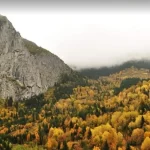Mount Rakaposhi : Crown of Snow
Rakaposhi Mountain, located in Pakistan’s Karakoram Range, is a majestic peak with an elevation of 7,788 meters. Meaning “Shining Wall” in its native tongue, Rakaposhi is a natural wonder that captivates mountaineers with its grandeur and challenging climbing routes. The legends, geographical features, and the inspiration it provides make this mountain truly unique. Mount Rakaposhi : Crown of Snow
The Majesty of Nature
Rakaposhi rises in relative isolation compared to many other peaks in the Karakoram Range. This isolation makes it even more striking when viewed from the surrounding valleys. The mountain is surrounded by the lush landscapes of the Hunza Valley, famous for its natural beauty and the cultural heritage of its centuries-old inhabitants. Rakaposhi is known not only for its height but also for its snow-clad, icy, and rugged slopes. It serves as a powerful reminder of both nature’s might and fragility.
Geographical and Climatic Features
The summit of Rakaposhi frequently hosts snow and ice storms. These harsh weather conditions make the mountain’s climbing routes exceedingly dangerous. However, such challenges have become a draw for adventurers seeking thrills. Rakaposhi’s glaciers are a vital part of the regional ecosystem and serve as a crucial water source for local communities.
The fauna and flora around Rakaposhi are also remarkably diverse. While life is scarce near the summit due to harsh conditions, the lower elevations are home to a variety of plant and animal species, contributing to the area’s ecological richness.
Climbing History
The first successful ascent of Rakaposhi was achieved in 1958 by a British-Pakistani team. Climbers Mike Banks and Tom Patey reached the summit despite severe weather conditions, etching their achievement into mountaineering history. Since then, ascents of Rakaposhi have remained limited, primarily due to the technical difficulty of its routes and the unpredictable weather.
Cultural and Spiritual Significance
For the local people, Rakaposhi is more than just a mountain; it is a symbol of sanctity. The residents of the Hunza Valley believe this peak profoundly influences their lives, both physically and spiritually. Rakaposhi’s grandeur frequently appears in local poetry, folklore, and songs.
Rakaposhi for Modern Visitors and Climbers
Today, Rakaposhi attracts not only professional climbers but also nature enthusiasts. Trekking routes such as the Rakaposhi Base Camp offer less dangerous yet breathtaking experiences. Visitors can camp here, marvel at the mountain’s beauty up close, and interact with the hospitable local people.
Conclusion
Rakaposhi is one of nature’s most awe-inspiring wonders. Its majesty, role as a life-sustaining resource for its surroundings, and status as a symbol of inspiration enhance its significance. The snow-draped summit of Rakaposhi resembles a crown reaching into the heavens, making it an unforgettable landmark in the hearts of nature lovers and adventurers alike.
What does the name “Rakaposhi” mean?
Where is Rakaposhi located?
How high is Rakaposhi Mountain?
What makes Rakaposhi unique compared to other peaks in the Karakoram Range?
What is the significance of Rakaposhi’s glaciers?
When was the first successful ascent of Rakaposhi?
Who were the climbers that first reached Rakaposhi’s summit?
Why is Rakaposhi considered challenging for climbers?
What kind of biodiversity can be found around Rakaposhi?
What cultural significance does Rakaposhi hold for the local people?
What activities can visitors enjoy around Rakaposhi?
How does Rakaposhi contribute to the local culture and economy?
What kind of weather can climbers expect on Rakaposhi?
Is Rakaposhi accessible for non-climbers?
Rakaposhi often called “Crown of Snow”?
The World’s 100 Highest Mountains by Country and Continent
Google Maps and Photos





